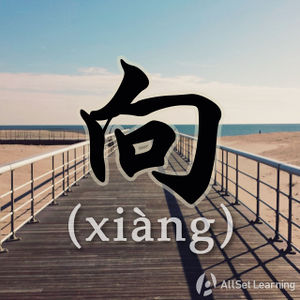Comparing "chao" "xiang" and "wang"
-
Level
-
Similar to
-
Used for
-
Keywords
All three of these, 朝 (cháo), 向 (xiàng), and 往 (wǎng) can be used to indicate direction or position. When these preposition phrases are used before a verb, the three have the same structure and their meaning is the same. Although they are often interchangeable, there are also cases when they are not.
Contents
When 朝, 向, and 往 Are All Appropriate
Structure
Just put one of the three before the direction and the verb!
向 / 朝 / 往 + Direction + Verb
Examples
The three are interchangeable in these types of "purely directional" usage.
- 从 这里 向 / 朝 / 往 北 走 两 百 米 就 到 了。From here, go one hundred meters north, and you'll get there.
- 这 个 小 女孩 向 左 看看 又 向 右 看看 才 过 马路。This little girl looked left and then looked right before crossing the street.
- 我 看见 他 朝 你们 家 去 了。I saw him going towards your house.
- 往 前 走 十 分 钟。Walk forward for ten minutes.
When to Use 向 and 往
向 and 往 can sometimes be placed after a verb, however not just any verb will do. Oft-used verbs are 开, 飞, 发, 运, 送, 寄, 带, 驶 etc. As you can see, these are words that imply some sort of motion. In addition, compared to 向, 往 is used more often with those verbs, because 往 indicates the destination while 向 merely expresses a direction,. 朝 is not used this way.
Structure
Verb + 向 / 往 + Direction
Examples
- 这 趟 火车 开往 沈阳。This train is heading towards Shenyang.
- 这 趟 航班 飞往 纽约。This plane is bound for New York.
- 一 辆 黑色 的 小 轿车 慢慢 地 从 东 驶向 西。A small black sedan slowly drove from east to west.
- 像 鸟儿 一样 飞向 蓝天。Like a bird, it flew into the blue yonder.
When to Use "向" and "朝"
When a concrete action has a specific target (not a destination), use 向 or 朝. 往 cannot be used this way.
Structure
向 / 朝 + Target + Concrete Verb
Examples
- 他 向 / 朝 我 笑 了 笑。He chuckled at me.
- 我 朝 他 开 了 一 枪。I took a shot at him.
- 他 已经 向 全体 员工 解释 过 了。He has already explained it to all the employees.
When Only "向" Is Correct
When a verb and or the target of the verb is abstract, you can only use 向 to indicate the target, and cannot use 朝.
Structure
向 + Target + Abstract Verb
Examples
- 他 是 优秀 员工,我们 都 要 向 他 学习。 He is an exemplary employee, we should all learn from him.
- 我们 要 向 环保 部门 要求 严查 工厂 排污。We are going to demand that the Environmental Safety Department closely inspect the factory's sewage.
Common Mistakes
- 这 个 地铁 是 开朝 浦东 机场 的 吗 ?
- 这 个 地铁 是 开往 浦东 机场 的 吗 ?Is this subway heading towards Pudong Airport?
- 你 要 多 往 雷锋 同志 学习 。
- 你 要 多 朝 雷锋 同志 学习 。
- 你 要 多 向 雷锋 同志 学习 。You need to go to him to learn.
- 帅哥 往 我 笑 了 一下 。When the handsome guy headed my way I smiled.
- 帅哥 朝 我 笑 了 一下 。When the handsome guy headed my way I smiled.
- 帅哥 向 我 笑 了 一下 。The cute guy smiled at me.
Example dialog
- A: 他 往 南 走 了 。He walked south.
- B: 笨蛋 ! 你 怎么 让 他 往 南 走 呢 ?南边 很 危险 !Idiot! Why did you let him go south? Going south is dangerous!
- A: 你 朝 我 发 什么 火 ?我 说 了 他 不 听 。Why are you getting mad at me? I told him but he didn't listen
- B: 不好意思 ,我 应该 向 你 道歉 。I'm sorry. I should apologize to you.
Sources and further reading
Books
- 现代汉语八百词(增订本) (pp. 196) [ →buy]
- 现代汉语虚词例释 (pp. 79, 505) 卓越汉语-公司实战篇 →buy



